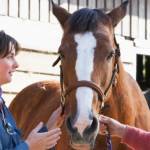Determining Degree of Lameness in Laminitic Horses

Inflammation of the sensitive laminae within a horse’s hooves, called laminitis, causes severe pain in the acute stage, with some amount of chronic pain and lameness often lasting for long periods after the initial stage has passed. Usually the level of pain determines the amount of lameness, and horses that are extremely painful and lame have a less positive prognosis. A common method of determining overall lameness and the degree of pain in each hoof is to jog a horse on a hard surface, watching the gait and seeing which feet are favored most.
In a study conducted at the Hoof Diagnostic and Rehabilitation Clinic, David Hood, D.V.M., and his colleagues evaluated the degree of lameness in 30 horses with laminitis. He also took radiographs to determine which feet were affected. Each horse then stood on a force plate as researchers recorded the amount of weight supported by each foot. They found that the center of load indicated the least lame foot; all horses loaded front hooves unequally, with most horses showing a load difference of more than 5% between the forefeet; and horses displacing the greatest degree of weight to the hindquarters were the most lame.
It was concluded that the force plate method of determining the degree of pain and lameness in laminitic horses was safe, accurate, and as helpful for diagnosis as jogging horses. Veterinarians could use this tool instead of a visual evaluation when examining and determining treatments for horses with laminitis.








